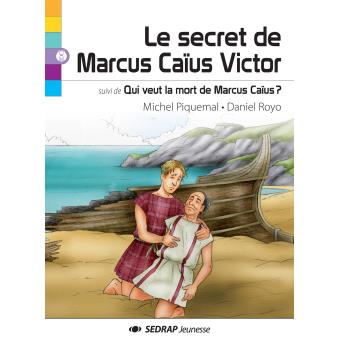Title of the work
Country of the First Edition
Country/countries of popularity
Original Language
First Edition Date
First Edition Details
Piquemal, Michel et Daniel Royo, Illustrations de Gwendal Lazzara, Le secret de Marcus Caïus Victor, suivi de Qui veut la mort de Marcus Caïus? Toulouse: Sédrap Jeunesse, 2011, 47 pp.
ISBN
Genre
Action and adventure fiction
Historical fiction
Illustrated works
Instructional and educational works
Short stories
Cover

Courtesy of the Publisher.
Author of the Entry:
Elżbieta Olechowska, University of Warsaw, elzbieta.olechowska@gmail.com
Peer-reviewer of the Entry:
Susan Deacy, University of Roehampton, s.deacy@roehampton.ac.uk

Gwendal Lazzara
, b. 1974
(Illustrator)
Born in Finistère, in the extreme west of Brittany, Lazzara lives in the region of Quimper, the capital city of the Department. Initially he studied drawing and painting, then, later, Celtic Languages at the University of Rennes. After a military service in the French Navy, he began working for a publisher of children’s books and teaching Breton. His illustrations appear in magazines and books. He is particularly fascinated by historical illustration and reconstruction, as a way better to grasp the spirit of his favourite periods of the past.
He also produces illustrations for computer applications used in pedagogical DVDs.
Source:
Official website (accessed: June 3, 2018).
Bio prepared by Elżbieta Olechowska, University of Warsaw, elzbieta.olechowska@gmail.com

Portrait (accessed: May 28, 2018): Michel Piquemal au 7e salon du livre de jeunesse à Cormontreuil, March 2012, photo by Garitan, licenced under Creative Commons Attribution-Share Alike 3.0, f
Michel Piquemal
, b. 1954
(Author)
Born on December 17, 1954 in Béziers (Hérault, France). He studied literature, comparative literature, and education; worked until 1988 as a primary school teacher. Authored over two hundred books for children and YA, writes texts for comic books, song lyrics, television scripts, articles in children’s periodicals. One of his favourite themes is philosophy, another… the American Indians. He produces an average of six books per year. He tried many different genres, including detective stories, theatre, heroic fantasy.
In 1989, he won the grand prize for a book for youth awarded by the French Ministry of Youth & Sports for his novel Le Jobard. He created a collection Carnets de sagesse published at Éditions Albin Michel to which he contributed himself several volumes.
La Chanson des Sirènes won the Prix Jeunesse Mousse du Salon du livre maritime in Concarneau in 1999 (see here, accessed: June 3, 2018).
Michel Piquemal’s Works Inspired by Antiquity – bolded titles refer to texts included in the survey.
Piquemal, Michel. Petite anthologie de la Mythologie. Toulouse: Éditions Sédrap, 1996. Collection Genres Littéraires au Collège.
Piquemal, Michel. La chanson des sirènes. Album pour les 7- 12 ans, illustré par Max Cabanes. Toulouse: Éditions Milan, 1998. Gd Prix salon livre Concarneau 1999.
Piquemal, Michel. Les Philo-Fables. 60 Fables accompagnées de questions, de repères et de mots-clés; dès 9 ans. Paris : Éditions Albin Michel, 2003.
Translation : Chinese, Spanish, Korean, Greek, Hebrew, Brasilian Portuguese, Italian, Serbian,Polish
Sound version: Montreal: Éditions Stanké, s.d.
Piquemal, Michel. Petites & grandes fables de Sophios. Paris: Éditions Albin Michel, 2004.
Translation: Chinese, German, Japanese, Italian Sound version: Montreal: Éditions Stanké, s.d.
Piquemal, Michel. Récits fabuleux de la mythologie: amours, ruses et jalousies, Paris: Éditions Albin Michel, 2006. Vol.1 .
Translations: Chinese, Italian
Sound version: Montreal: Éditions Stanké, s.d.
Piquemal, Michel. Récits fabuleux de la mythologie: les héros et les monstres [Fabulous Mythological Tales : Heroes and Monsters]. Paris: Éditions Albin Michel, octobre 2006. Vol. 2.
Translation : Chinese
Sound version: Paris: Éditions Albin Michel, s.d.
Piquemal, Michel. Les Philo-Fables, Paris: Livre de Poche, mai 2010.
Vol. 1-2 for adult reader.
Piquemal, Michel et Daniel Royo. Le secret de Marcus Caïus Victor, roman historique pour les 8/12 ans au coeur de la Gaule narbonnaise. Illustrations de Gwendal Lazzara. Toulouse: Éditions Sédrap, novembre 2011
Piquemal, Michel. Récits fabuleux de la mythologie. Illustrations by Séverin Millet. Paris: Éditions Albin Michel, 07.12.2012.
Sources:
Michel Piquemal’s official website (accessed: June 3, 2018).
Full bibliography of books by Michel Piquemal is posted here (accessed: June 3, 2018).
Bio prepared by Elżbieta Olechowska, University of Warsaw, elzbieta.olechowska@gmail.com

Daniel Royo
, b. 1956
(Author)
Born in Bram near Carcassonne in the South of France, Royo has remained in the region during his entire career, first as a teacher, and then as school inspector and author of books for children on historical (also ancient) themes and collections of stories and legends, including L'aigle de Titus 1999, Hercule, Thésée et autres légendes grecques Cycle 3 2000, Ali Baba et autres contes des Mille et Une Nuits 2000, La Barbe-Bleue et autres contes de Perrault 2003, Les six serviteurs et autres contes de Grimm 2003, Sindbad le marin: Un conte des Mille et Une Nuits 2003.
Bio prepared by Elżbieta Olechowska, University of Warsaw, elzbieta.olechowska@gmail.com
Summary
In Rome under Augustus, an orphan named Lucius from a wealthy Roman family has been brought up by his grandfather, Marcus Caïus Victor*, the owner of prestigious jewellery workshops and an influential magistrate (Decurion). To the boy’s utter amazement, he learns from his grandfather that he was originally a Gaul who fought for Vercingetorix at Alesia, was taken prisoner, and then sold as a slave to an important Roman merchant. On their trip to Rome, they were shipwrecked and Marcus saved his master’s life. He was later freed and adopted by Quintus Caïus Victor, the grateful merchant, whose daughter Flavia Domitia – Lucius’ grandmother – he eventually married. Now in his old age, Marcus wants to see his native Gaul again and to show the country to Lucius, as well as to visit his granddaughter who lives there and divide his fortune between her and Lucius. For many years, Marcus has been regularly sending his accountant Gallus to Bibracte, his native village, with gifts of money for his family there. Gallus told him that his brother Grobix, also an excellent jeweller, passed away as did his daughter but that a granddaughter was alive and well. Marcus and Lucius, accompanied by the accountant Gallus, left from the port of Ostia and travelled to Narbo Martius in Gaul.
The second part of the story – entitled Who Wants Marcus Caïus Dead? – begins when Marcus and Lucius arrive in Gaul and continue their travel by a riverboat towards Bibracte. During the trip, somebody tries first, unsuccessfully, to poison Marcus. When he dies one night, Lucius suspects that his grandfather was smothered with his own pillow. Lucius decides to reach Bibracte and cremate his grandfather in the village of his ancestors. The accountant insists on a rapid burial but Lucius disagrees and continues the journey to Bibracte. Contrary to Gallus’ reports from his annual trips to Gaul, Marcus’ brother, Grobix, is still alive and warmly receives Lucius. It comes out that Gallus never contacted Grobix and was pocketing the money for himself. He murdered Marcus because he had been afraid of being discovered and punished for his theft and lies. Grobix and Lucius outsmart Gallus who is accidentally killed by horses when he attempts to flee. Lucius begins to work in Grobix’ workshops and is happy to find his Gallic family; he wonders whether he will ever go back to his native city of Rome.
* His Gallic name is Dividiac, a variation on the only attested name of a Druid of the Aedui, Divitiacus. Ceasar mentions him in his Commentarii de Bello Gallico 1, 3; 16; 31; 2, 5; 14; 6, 12; 7, 39 and Cicero writes about him in De divinatione 1, 41.
Analysis
The content of the book clearly qualifies it for inclusion in the database. A fictional adventure of an adolescent allows for presenting the historical reality of everyday life in the early 1st century A. D. The novel serves as an aid for teaching the ancient history of France – Gaul, as a Roman province. It describes the situation of Roman citizen versus non-citizens born in the provinces, travels from Rome to Gaul, and the way of life under Augustus in Rome and in Gaul. A short final section of the book (Á propos de…) provides brief factual information on Rome, the siege of Alesia, Roman Gaul, and the town of Bibracte with its Aedui inhabitants.
Further Reading
Mekouar, Myriam, «Quand la littérature ne prend pas l’enfant pour une bille ! – interview avec Michel Piquemal», "La Pause Philo," 9 July 2020 (accessed October 26, 2020).
Nières-Chevrel, Isabelle, Introduction à la littérature de jeunesse, Paris: Didier Jeunesse, 2009.
Prince, Nathalie and Sylvie Servoise, Les personnages mythique dans la littérature de jeunesse, Rennes: Presses Universitaires de Rennes, 2015.
Addenda
The Author’s Official Site: Michelpiquemal.com (accessed: November 22, 2022).


